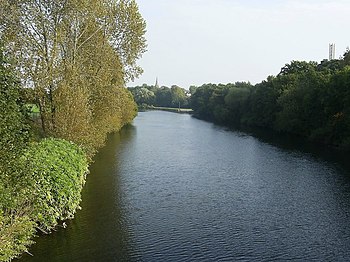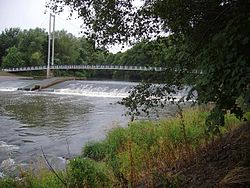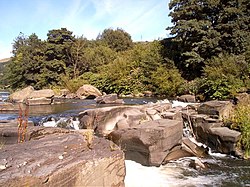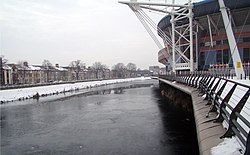River Taff
The River Taff is the principal river of Cardiff in Glamorgan
The Taff is a sizable river. It rises as two rivers in the Brecon Beacons — the Taf Fechan (Little Taff) and the Taf Fawr (Big Taff) — which unite to form the Taff north of Merthyr Tydfil. Notwithstanding the urban and industrial nature of the riverside towns, the Taff supports a number of migratory fish, including salmon, sea trout, and eels.
Contents
Course
From its confluence at Cefn-Coed-y-Cymer, the river flows south, passing several towns. It picks up a few tributaries, such as the River Cynon, River Rhondda, Bargoed Taf and Nant Clydach. It flows underneath the M4 Motorway, before turning southeastward and flowing through the Cardiff suburbs of Radyr, Whitchurch, Llandaff, Pontcanna, the city centre and Grangetown, before emptying into Cardiff Bay, near to the mouth of the River Ely.
Diversion in Cardiff
In the early 1840s the South Wales Railway was trying to find a suitable site for a railway station, but the area that is now Cardiff Central railway station was prone to flooding. At this point the main route of the Taff was around Cardiff Castle and down what is now Westgate Street, and the land where Cardiff Arms Park and the Millennium Stadium now stand wre tidal flats prone to flooding.
It was Isambard Kingdom Brunel's solution to divert the Taff to the west, creating a larger and safer site for the station. The station was opened by the South Wales Railway in 1850.[1]
Taf Fawr
The Taf Fawr rises below Corn Du, south-west of Pen y Fan and flows south through Beacons Reservoir, Cantref Reservoir and Llwyn-on Reservoir.
Taff Fechan
The Taff Fechan rises immediately to the south of Pen y Fan and runs southwards through the two Neuadd Reservoirs, Pentwyn Reservoir and finally Pontsticill reservoir before descending into a wooded gorge and flowing south-westwards around the Gurnos estate. To the south of Cefn-coed-y-cymmer, the Taf Fechan and Taf Fawr merge at the wooded confluence that gives Cefn-coed-y-cymmer its name.
Tributaries
Nant Ffrwd
Underneath Cefn Viaduct, the Nant Ffrwd, a tributary that runs eastward in a deep wooded gorge before flowing into the Taf Faw above the confluence with the Taf Fechan, emerges into the river from a deep, narrow gorge.
Nant Morlais and Nant Rhydycar
The Taff continues south through the centre of Merthyr Tydfil, where it is joined by the Nant Morlais which emerges at Abermorlais from a culvert in the east bank. Just south of Merthyr weir, the Nant Rhydycar joins.
Taff Bargoed, Cynon, Nant Clydach and Rhondda
South of Merthyr, the Taff begins to meander its way between Pentrebach and Abercanaid and through Troedyrhiw, Merthyr Vale and Aberfan towards Quakers Yard. Here, the Taff Bargoed and then down into Abercynon in the Cynon Valley where the River Cynon merges with the Taff and, slightly further downstream the Nant Clydach joins. At Pontypridd it is joined by the River Rhondda. From Pontypridd, it runs roughly south, through Taff's Well and Radyr, before arriving at the northern boundary of the city of Cardiff in Llandaff.
Mouth of the Taff
In Cardiff, the natural course of the river was changed during the 19th century; from Cardiff Castle it now follows an artificial riverbed west of where it previously flowed, now following a path through Bute Park and next to the Cardiff Arms Park and the former National Stadium, now the Millennium Stadium, and into Cardiff Bay, which has now become an artificial lake due to the construction of a barrage across the mouth of this river and the River Ely. The waters then flow out into the Severn estuary.
Outside links
- Glamorgan-Gwent Archaeological Trust Merthyr Tydfil Features
References
- ↑ "Cardiff Arms Park, A short History - The Creation of the Arms Park". Cardiff Council. http://cricketarchive.com/Glamorgan/History/Cardiff_Arms_Park/Creation.html. Retrieved 2008-05-22.




